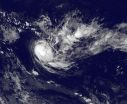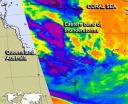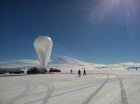(Press-News.org) New York, NY—January 24, 2013—Samuel K. Sia, associate professor of biomedical engineering at Columbia Engineering, has taken his innovative lab-on-a-chip and developed a way to not only check a patient's HIV status anywhere in the world with just a finger prick, but also synchronize the results automatically and instantaneously with central health-care records—10 times faster, the researchers say, than the benchtop ELISA, a broadly used diagnostic technique. The device was field-tested in Rwanda by a collaborative team from the Sia lab and ICAP at Columbia's Mailman School of Public Health.
In the study published online January 18, 2013, in Clinical Chemistry, and in the print April 2013 issue, Sia describes a major advance towards providing people in remote areas of the world with laboratory-quality diagnostic services traditionally available only in centralized health care settings.
"We've built a handheld mobile device that can perform laboratory-quality HIV testing, and do it in just 15 minutes and on finger-pricked whole blood," Sia says. "And, unlike current HIV rapid tests, our device can pick up positive samples normally missed by lateral flow tests, and automatically synchronize the test results with patient health records across the globe using both the cell phone and satellite networks."
Sia collaborated with Claros Diagnostics (a company he co-founded, now called OPKO Diagnostics) to develop a pioneering strategy for an integrated microfluidic-based diagnostic device—the mChip—that can perform complex laboratory assays, and do so with such simplicity that these tests can easily be carried out anywhere, including in resource-limited settings, at a very low cost. This new study builds upon his earlier scientific concepts and incorporates a number of new engineering elements that make the test automated to run with data communication over both cell phone and satellite networks.
"There are a set of core functions that such a mobile device has to deliver," he says. "These include fluid pumping, optical detection, and real-time synchronization of diagnostic results with patient records in the cloud. We've been able to engineer all these functions on a handheld mobile device and all powered by a battery."
This new technology, which combines cell phone and satellite communication technologies with fluid miniaturization techniques for performing all essential ELISA functions, could lead to diagnosis and treatment for HIV-infected people who, because they cannot get to centralized health care centers, do not get tested or treated.
"This is an important step forward for us towards making a real impact on patients," says Jessica Justman, MD, senior technical director at ICAP and associate clinical professor of medicine in epidemiology at the Mailman School of Public Health. "And with the real-time data upload, policymakers and epidemiologists can also monitor disease prevalence across geographical regions more quickly and effectively."
Working with ICAP, OPKO, the Rwandan Ministry of Health, and Rwandan collaborators at Muhima Hospital and two health clinics—Projet San Francisco and Projet Ubuzima, Sia and his team assessed the device's ability to perform HIV testing and then synchronized results in real time with the patients' electronic health records. They successfully tested over 200 serum, plasma, and whole blood samples, all collected in Rwanda.
The mobile device also successfully transmitted all whole-blood test results from a Rwandan clinic to a medical records database stored on the cloud. The device produced results in agreement with a leading ELISA test, including detection of weakly positive samples that were missed by existing rapid tests. The device operated autonomously with minimal user input, produced each result in 15 minutes (compared to 3 hours with the benchtop ELISA), and consumed as little power as a mobile phone.
This latest study builds on previous work from the Sia Lab on building a lab-on-a-chip for personal health diagnosis. For this earlier device, Columbia University was named a Medical Devices runner-up in The Wall Street Journal's prestigious Technology Innovation Awards in 2011.
This research has been funded by a $2-million Saving Lives at Birth transition grant (United States Agency for International Development, the Bill & Melinda Gates Foundation, Government of Norway, Grand Challenges Canada, and the World Bank).
Sia's next step will be to implement an antenatal care panel for diagnosing HIV and sexually transmitted diseases for pregnant women in Rwanda. He is also exploring the use of this technology for improving personal health for consumers in the United States.
"The ability to perform state-of-the-art diagnostics on mobile devices has the potential to revolutionize how patients manage their health," Sia says. "I'm pleased with the progress we have made so far, and we are working hard with our collaborators to bring this technology to clinicians, patients, and consumers."
INFORMATION:
Fast, low-cost device uses the cloud to speed up diagnostic testing for HIV and more
Mobile device can easily be used in remote areas around the world
2013-01-25
ELSE PRESS RELEASES FROM THIS DATE:
Ractopamine is safe for use in Brazilian pork
2013-01-25
Animal scientists in Brazil have found that a small dose of the feed additive ractopamine can boost pork production without changing how pork looks or tastes.
In the latest issue of the Journal of Animal Science, researchers report that a 5 mg/kg dose of ractopamine increased muscle mass and feed efficiency, and had no noticeable effect on pork marbling, fat content, toughness or color. The researchers came to this conclusion by testing pork from 340 pigs raised under commercial conditions.
"We found that if [pork producers] use 5 mg/kg of ractopamine in the finishing ...
Researchers say it's time to treat anemia seriously
2013-01-25
TORONTO, Jan. 24, 2013—Up to one-third of patients undergoing surgery in Ontario have a treatable form of anemia but are not optimally treated for it.
A paper published online today in the Canadian Journal of Anesthesia says that hospitals that do treat patients with anemia have better outcomes, including fewer blood transfusions and infections and shorter hospital stays.
A common option for management of anemia has been blood transfusion. But blood transfusions are expensive and are associated with higher death and complication rates.
Dr. Gregory Hare, an anesthesiologist ...
Digital diagnostic tools lead to patient dissatisfaction, says MU expert
2013-01-25
COLUMBIA, Mo. – Health care practitioners now can access patients' data using electronic medical records, which often include information systems that assess individuals' medical histories and clinical research to facilitate doctors' diagnoses. A University of Missouri researcher says the increased use of computerized clinical decision support systems (CDSSs) leads to greater patient dissatisfaction and could increase noncompliance with preventative care and treatment recommendations.
Victoria Shaffer, an assistant professor of health sciences and psychological sciences, ...
Liquid metal makes silicon crystals at record low temperatures
2013-01-25
ANN ARBOR—A new way of making crystalline silicon, developed by U-M researchers, could make this crucial ingredient of computers and solar cells much cheaper and greener.
Silicon dioxide, or sand, makes up about 40 percent of the earth's crust, but the industrial method for converting sand into crystalline silicon is expensive and has a major environmental impact due to the extreme processing conditions.
"The crystalline silicon in modern electronics is currently made through a series of energy-intensive chemical reactions with temperatures in excess of 2,000 degrees ...
Stigma stymies prostate cancer screening, treatment in Ghana
2013-01-25
PHILADELPHIA—Infectious diseases in Ghana tend to capture the most attention, but a quiet crisis may soon take over as the country's most threatening epidemic: cancer.
A new study published in January in the journal BMC Cancer, led by Kosj Yamoah, M.D., Ph.D., a resident in the Department of Radiation Oncology at Thomas Jefferson University and Hospital, takes aim at the issue by investigating prostate cancer diagnoses and treatment delivery in black men living in the West African region, in order to devise research strategies to help improve health outcomes.
Overall, ...
Study: Store layout an important variable for retailers
2013-01-25
CHAMPAIGN, Ill. — A retailer's optimal store layout is the result of balancing the interests of two different types of markets – consumers and suppliers, says new research co-written by a University of Illinois business professor.
According to Yunchuan "Frank" Liu, a retailer's strategic manipulation of store layout is driven by an incentive to balance the shopping process of "fit-uncertain consumers" and the pricing behavior of upstream suppliers.
"Retailers face two different kinds of markets – the consumers who buy goods, and the manufacturers that supply goods," ...
NASA sees Tropical Cyclone Garry continue to intensify
2013-01-25
Tropical Cyclone Garry is in a good environment to intensify and satellite imagery from NOAA's GOES-15 satellite helped confirm that the storm has become more organized.
NOAA's GOES-15 satellite captured an infrared image of Tropical Storm Garry when it was located about 330 nautical miles (379.8 miles/ 611.2 km) east of Pago Pago, American Samoa. The image, created by the NASA GOES Project at the NASA Goddard Space Flight Center in Greenbelt, Md., was taken Jan. 24 at 1500 UTC (10 a.m. EST). The image showed a bright white circle of clouds that indicate strong thunderstorms ...
NASA sees remnants of Tropical Storm Oswald still strong
2013-01-25
Infrared imagery from NASA's Aqua satellite revealed that a band of thunderstorms on the eastern side of Tropical Storm Oswald's remnants still contained some punch. Oswald's remnants have triggered severe weather warnings in parts of Queensland, Australia.
When NASA's Aqua satellite passed over the eastern side of the remnants of Tropical Cyclone Oswald the Atmospheric Infrared Sounder (AIRS) instrument captured an infrared image of a powerful band of thunderstorms over the Coral Sea. The band of thunderstorms east of Oswald's center showed some strong convection and ...
NASA Super-TIGER balloon shatters flight record
2013-01-25
Flying high over Antarctica, a NASA long duration balloon has broken the record for longest flight by a balloon of its size.
The record-breaking balloon, carrying the Super Trans-Iron Galactic Element Recorder (Super-TIGER) experiment, has been afloat for 46 days and is on its third orbit around the South Pole.
"This is an outstanding achievement for NASA's Astrophysics balloon team," said John Grunsfeld, associate administrator for the Science Mission Directorate at NASA Headquarters in Washington. "Keeping these huge balloons aloft for such long periods lets us do ...
Fetal exposure to tributyltin linked to obesity
2013-01-25
Irvine, Calif. (Corrected version) — Exposing pregnant mice to low doses of the chemical tributyltin (TBT) – which was used in marine antifouling paints and is used as an antifungal agent in some paints, certain plastics and a variety of consumer products – can lead to obesity for multiple generations without subsequent exposure, a UC Irvine study has found.
After exposing pregnant mice to TBT at low concentrations, similar to those found in the environment and in humans, researchers observed increased body fat, liver fat and fat-specific gene expression in liver and ...
LAST 30 PRESS RELEASES:
Pure bred: New stem cell medium only has canine components
Largest study of its kind highlights benefits – and risks – of plant-based diets in children
Synergistic effects of single-crystal HfB2 nanorods: Simultaneous enhancement of mechanical properties and ablation resistance
Mysterious X-ray variability of the strongly magnetized neutron star NGC 7793 P13
The key to increasing patients’ advance care medical planning may be automatic patient outreach
Palaeontology: Ancient tooth suggests ocean predator could hunt in rivers
Polar bears may be adapting to survive warmer climates, says study
Canadian wildfire smoke worsened pediatric asthma in US Northeast: UVM study
New UBCO research challenges traditional teen suicide prevention models
Diversity language in US medical research agency grants declined 25% since 2024
Concern over growing use of AI chatbots to stave off loneliness
Biomedical authors often call a reference “recent” — even when it is decades old, analysis shows
The Lancet: New single dose oral treatment for gonorrhoea effectively combats drug-resistant infections, trial finds
Proton therapy shows survival benefit in Phase III trial for patients with head and neck cancers
Blood test reveals prognosis after cardiac arrest
UBCO study finds microdosing can temporarily improve mood, creativity
An ECOG-ACRIN imaging study solves a long-standing gap in metastatic breast cancer research and care: accurately measuring treatment response in patients with bone metastases
Cleveland Clinic presents final results of phase 1 clinical trial of preventive breast cancer vaccine study
Nationally renowned anesthesiology physician-scientist and clinical operations leader David Mintz, MD, PhD, named Chair of the Department of Anesthesiology at the UM School of Medicine
Clean water access improves child health in Mozambique, study shows
Study implicates enzyme in neurodegenerative conditions
Tufts professor named Fellow of the National Academy of Inventors
Tiny new device could enable giant future quantum computers
Tracing a path through photosynthesis to food security
First patient in Arizona treated with new immune-cell therapy at HonorHealth Research Institute
Studies investigate how AI can aid clinicians in analyzing medical images
Researchers pitch strategies to identify potential fraudulent participants in online qualitative research
Sweeping study shows similar genetic factors underlie multiple psychiatric disorders
How extreme weather events affect agricultural trade between US states
Smallholder farms maintain strong pollinator diversity – even when far from forests
[Press-News.org] Fast, low-cost device uses the cloud to speed up diagnostic testing for HIV and moreMobile device can easily be used in remote areas around the world





